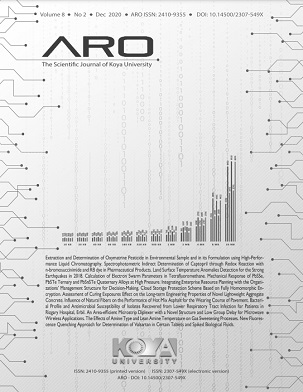The Effects of Amine Type and Lean Amine Temperature on Gas Sweetening Processes
A Case Study and Simulation
DOI:
https://doi.org/10.14500/aro.10738Keywords:
Gas sweetening, Lean amine temperature, Mixed amine, Natural gas industry, North gas company, Process simulationAbstract
In the North Gas Company (NGC) in Kirkuk, Iraq, sour gas stream is loaded with considerable amounts of H2S and CO2 of 2.95% and 2.54%, respectively. A DEA amine system is currently used to reduce these sour component concentrations below 5 ppm and 2% for H2S and CO2, respectively. This study used Bryan Research and Engineering’s ProMax® process simulation software to optimize this amine sweetening system by adopting other amine types and blends, such as methyldiethanolamine (MDEA). It could be argued that a 50 wt% MDEA solution circulated at 414 m3/h was determined to be the optimum operating conditions. This design met sweet gas specifications and minimized the reboiler duty to 38 MW, 30.9% reduction in steam consumption. The experimental simulation work is also examined the effects of lean solvent temperature on the gas sweetening process efficiency and performance and find out that the lean amine temperature within the range of 43–48°C in all sceneries give acceptable sweetening results.
Downloads
References
Abdel-Aal, H., Aggour, M. and Fahim, M., 2003. Petroleum and Gas Field Processing. Marcel Dekker, New York.
Abdulrahmanm, R.K., Zangana, M.H.S., Ali, K.S. and J.C. Slagle., 2017. Utilizing Mixed Amines In Gas Sweetening Process: A Kirkuk Field Case Study And Simulation IEEE Conference Publication. Available from: https://www.ieeexplore.ieee.org/document/8267616. [Last accessed on 2020 Dec 09].
Bre.com. 2020. Available from: https://www.bre.com/pdf/using-mixed-aminesolutions-for-gas-sweetening.pdf. [Last accessed on 2020 Feb 22].
Bre.com. 2020. Bryan Research and Engineering, LLC. Available from: https://www.bre.com. [Last accessed on 2020 Feb 14].
Davoudi, M., Safadoust, A., Mansoori, S.A. and Mottaghi, H., 2014. The impurities effect on thermal degradation and corrosivity of amine solution in South Pars gas sweetening plants. Journal of Natural Gas Science and Engineering, 19, pp.116-124.
Maddox, R. and Morgan, D., 1998. Gas Conditioning and Processing. Campbell Petroleum Series, Norman, Okla.
Poe, W. and Mokhatab, S., 2017. Modeling, Control, And Optimization Of Natural Gas Processing Plants. Gulf Professional, Amsterdam.
Sarker, N., 2016. Theoretical effect of concentration, circulation rate, stages, pressure and temperature of single amine and amine mixture solvents on gas sweetening performance. Egyptian Journal of Petroleum, 25(3), pp.343-354.
Shooshtari, S.R. and Shahsavand, A., 2013. Reliable prediction of condensation rates for purification of natural gas via supersonic separators. Separation and Purification Technology, 116, pp.458-470.
Sorensen, E., 2018. Chemical Engineering Research and Design. 1st ed. Institution of Chemical Engineers, London.
Stewart, M. and Arnold, K., 2011. Gas Sweetening And Processing Field Manual. Elsevier, Gulf Professional, Amsterdam.
Wang, X. and Economides, M., 2013. Advanced Natural Gas Engineering. Elsevier Science, Burlington.
Downloads
Published
How to Cite
Issue
Section
License
Authors who choose to publish their work with Aro agree to the following terms:
-
Authors retain the copyright to their work and grant the journal the right of first publication. The work is simultaneously licensed under a Creative Commons Attribution License [CC BY-NC-SA 4.0]. This license allows others to share the work with an acknowledgement of the work's authorship and initial publication in this journal.
-
Authors have the freedom to enter into separate agreements for the non-exclusive distribution of the journal's published version of the work. This includes options such as posting it to an institutional repository or publishing it in a book, as long as proper acknowledgement is given to its initial publication in this journal.
-
Authors are encouraged to share and post their work online, including in institutional repositories or on their personal websites, both prior to and during the submission process. This practice can lead to productive exchanges and increase the visibility and citation of the published work.
By agreeing to these terms, authors acknowledge the importance of open access and the benefits it brings to the scholarly community.
Accepted 2020-12-12
Published 2020-12-19
















 ARO Journal is a scientific, peer-reviewed, periodical, and diamond OAJ that has no APC or ASC.
ARO Journal is a scientific, peer-reviewed, periodical, and diamond OAJ that has no APC or ASC.